Interesting Facts About Corn You Never Knew
Did you know corn is more than just a tasty vegetable? It's a grain-fruit with ancient roots, domesticated over 10,000 years ago in Mexico. You'll be surprised to learn that corn's versatility extends beyond food. It's used in biodegradable plastics, cosmetics, and even crayons. The tallest corn stalk ever recorded reached a staggering 35 feet 3 inches! Corn also plays a significant role in global agriculture, with the U.S. producing about one-third of the world's supply. Nutritionally, it's packed with fiber, vitamins, and minerals. As you explore further, you'll uncover corn's fascinating cultural significance and environmental impact.
This post may contain affiliate links. If you make a purchase through these links, I may earn a commission at no additional cost to you. Additionally, portions of this post may be generated using artificial intelligence (AI) technology. While we strive for accuracy, please be aware that AI-generated content may not always be perfect and should be fact-checked when necessary.
The Spatula Scoops
- Corn was domesticated over 10,000 years ago in Mexico and held sacred status among Pre-Columbian civilizations.
- Each corn cob can contain up to 800 kernels, demonstrating its impressive reproductive capacity.
- The world record for corn stalk height is 35 feet 3 inches, achieved through selective breeding.
- Corn is used in non-food items like biodegradable plastics, cosmetics, and children's crayons.
- One acre of corn can sequester about 8 tons of carbon dioxide, aiding in climate change mitigation.
Corn's Ancient Origins
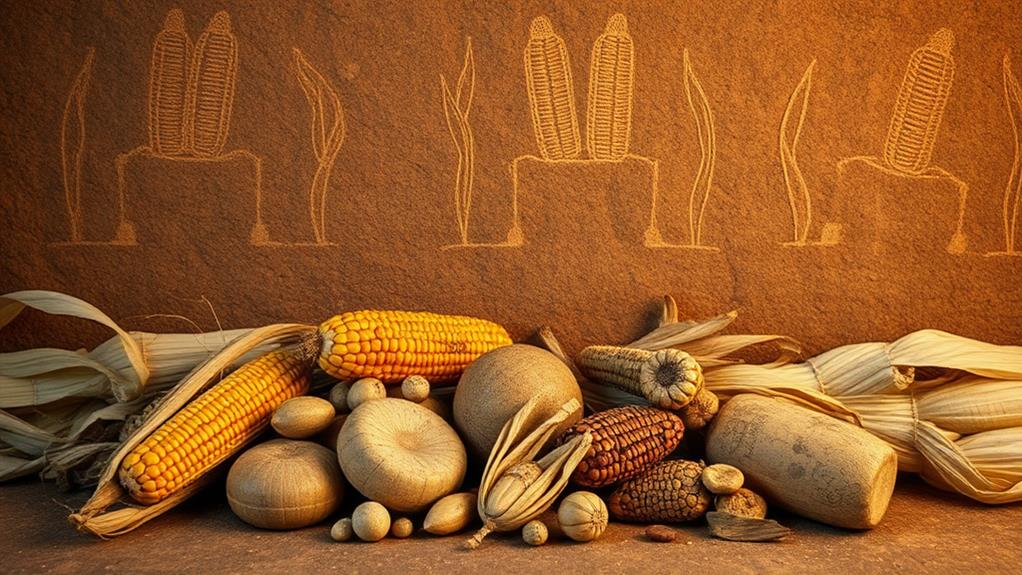
Corn's history stretches back over 10,000 years, kicking off in southern Mexico where it was first domesticated. You might be surprised to learn that this versatile crop, scientifically known as Zea mays, has been shaping human civilization for millennia. Archaeological evidence reveals corn's presence in ancient agricultural practices, demonstrating its significance to early societies.
The term "maize," which you've likely heard before, actually comes from the Taino word "mahiz," meaning "sacred mother" or "giver of life." This name reflects the crop's importance as a staple food for indigenous cultures across the Americas. After its initial domestication, corn spread rapidly throughout the continent, becoming an integral part of various cultures' diets and traditions.
It wasn't until Columbus's voyages in 1492 that corn was introduced to Europe. By the late 1700s, it had gained significant popularity and began influencing European agricultural practices. Today, maize cultivation continues to play an essential role in global food security and agricultural economies, with over 90 million acres dedicated to its production worldwide. This ancient crop's journey from its Mexican origins to global staple is a reflection of its adaptability and importance in human history.
The Versatile Grain-Fruit
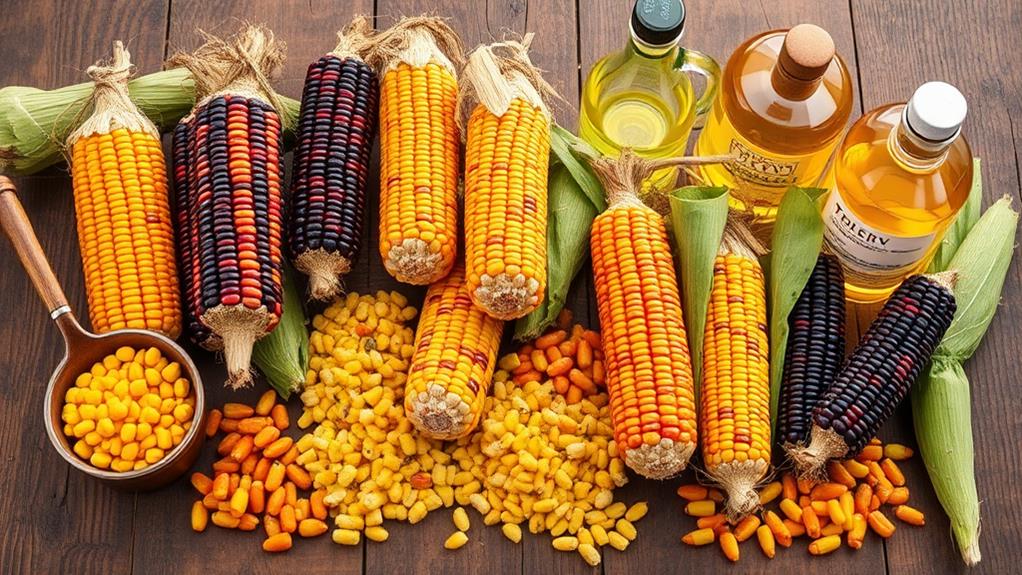
You might be surprised to learn that corn is classified as both a grain and a fruit, making it a truly versatile crop. This dual classification stems from its seed-bearing structure and its varied culinary applications, which range from cornmeal and popcorn to sweet corn on the cob. Whether you're enjoying it as a side dish or using it as an ingredient in baked goods, corn's adaptability in the kitchen is a demonstration of its unique botanical nature.
Corn's Dual Classification
In the world of botany and nutrition, corn stands out as a unique specimen with a dual identity. You might consider corn a vegetable when you're munching on a cob, but it's actually classified as both a grain and a fruit. Corn's scientific name is Zea mays, and it's a staple food source that's as versatile as it is complex.
Here's a breakdown of corn's dual classification:
| Aspect | Grain Classification | Fruit Classification | Vegetable Usage |
|---|---|---|---|
| Definition | Edible seed from grass family | Develops from plant's ovary | Culinary application |
| Structure | Kernel contains endosperm | Seed encased in cob | Eaten before full maturity |
| Usage | Milled for flour, meal | Whole kernels in dishes | Fresh or cooked dishes |
| Nutritional Focus | Carbohydrate source | Seed propagation | Dietary fiber, vitamins |
| Example Products | Cornmeal, corn syrup | Popcorn, corn oil | Sweet corn on the cob |
This dual nature allows corn to fit into multiple dietary categories and be used in various forms. Each cob can hold up to 800 kernels, showcasing the plant's impressive reproductive capacity. Understanding corn's classification helps you appreciate its versatility in your diet and cooking.
Diverse Culinary Applications
From breakfast to dinner and snacks in between, corn pops up in countless culinary applications. You'll find this versatile grain-fruit in various forms, from sweet corn on the cob to processed ingredients like corn syrup and corn oil. Cornmeal, a staple in many kitchens, forms the base of traditional dishes like grits and polenta, adapting to different cultural cuisines.
When you're reaching for a quick snack, you're likely to encounter corn in popular treats like popcorn and corn chips. These products showcase corn's ability to transform into diverse textures and flavors. In the food industry, corn's versatility extends even further. It's processed into an extensive range of products, becoming an integral ingredient in numerous recipes you might not even realize contain corn.
For the freshest flavor, you'll want to consume sweet corn soon after harvesting. It quickly turns starchy, affecting its taste and texture. This emphasizes the importance of timely consumption or proper preservation methods. Whether you're enjoying it fresh, processed, or as part of a complex dish, corn's culinary applications are truly diverse and far-reaching.
Record-Breaking Corn Stalks
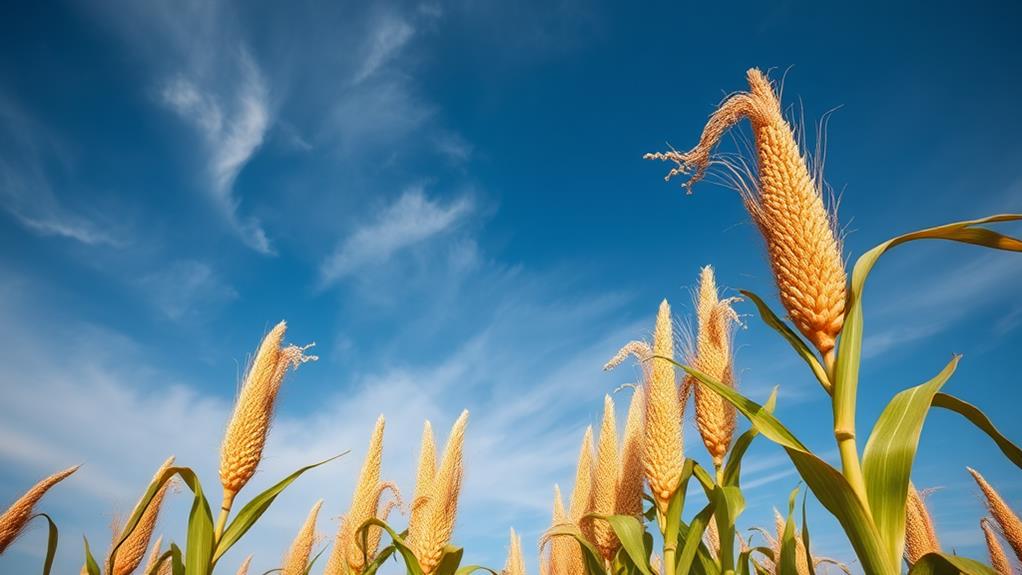
Towering over typical corn fields, record-breaking corn stalks have reached astonishing heights. You might be surprised to learn that the world record for the tallest corn stalk stands at an impressive 35 feet 3 inches. That's more than three stories high! This remarkable achievement wasn't a fluke; it resulted from carefully cultivated sweet corn varieties specifically bred for maximum growth.
Agricultural competitions often showcase these extraordinary specimens, highlighting advancements in corn cultivation techniques. These record-breaking stalks don't just happen by chance. They're the product of genetic advancements and selective breeding, pushing the boundaries of what's possible in corn growth. To reach such heights, these corn varieties require ideal conditions, including perfect temperature, soil quality, and moisture levels.
You'll find that these towering corn stalks aren't just for show. They represent the cutting edge of agricultural innovation, demonstrating the potential for increased crop yields and improved food production. While you won't see these giants in your local grocery store, they're a proof of human ingenuity in agriculture and our ongoing quest to push the limits of nature.
Corn's Global Agricultural Dominance

Corn's global dominance in agriculture is undeniable. You might be surprised to learn that the United States produces about one-third of the world's corn, making it the leading country in corn production and export. This impressive statistic underscores the crop's importance in global agriculture.
Corn's adaptability is truly remarkable. It's grown on every continent except Antarctica, showcasing its ability to thrive in various climates and soils. To put this into perspective, more than 90 million acres globally are dedicated to corn cultivation. In the U.S. alone, corn farmers planted 91.7 million acres in 2019, surpassing any other major crop.
Let's break down some key facts about corn's dominance:
| Region | Importance |
|---|---|
| United States | Top producer and exporter |
| Corn Belt | Essential for U.S. agricultural output |
| Global Acreage | Over 90 million acres |
| Types of Corn | Diverse varieties for various uses |
The Corn Belt, primarily encompassing states like Iowa, Illinois, and Nebraska, plays an important role in U.S. corn production. Its favorable conditions make it ideal for corn farming, contributing markedly to the country's agricultural output and global corn dominance.
Surprising Uses Beyond Food
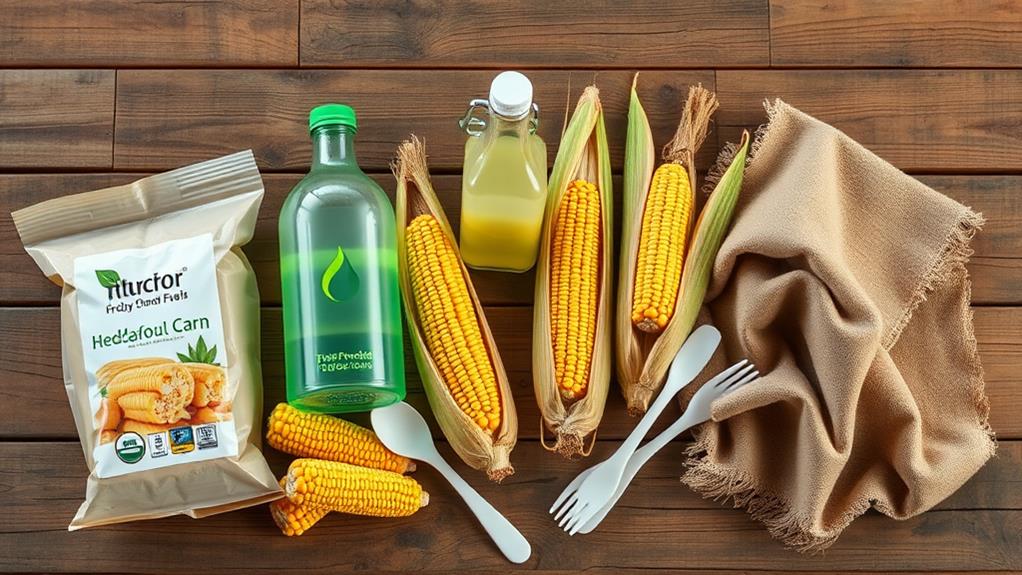
The versatility of corn extends far beyond the dinner table. You might be surprised to learn that corn is used in numerous non-food items you encounter daily. From biodegradable plastics to cosmetics and pharmaceuticals, corn's applications are vast and varied.
Consider these unexpected uses of corn:
- Your laundry detergent might contain corn-derived ingredients
- The crayons your children use could be made with corn byproducts
- Your car might run on ethanol, a fuel partially produced from corn
Corn byproducts play a vital role in manufacturing adhesives, paints, and textiles. Additionally, corn starch serves as a thickening agent in cooking and food processing, and it's also used in biodegradable packaging. This versatile grain contributes to reducing carbon emissions through ethanol production, offering an alternative to fossil fuels.
The importance of corn in various industrial applications can't be overstated. Its presence in everyday household items demonstrates its integral role in consumer goods. As you go about your day, you're likely interacting with corn-derived products more often than you realize, showcasing the grain's significance beyond its nutritional value.
Corn's Nutritional Profile

You'll find that corn packs quite a nutritional punch, offering a balance of calories and macronutrients. It's low in fat but high in carbohydrates, primarily starch, while also providing a decent amount of protein. Corn's nutritional profile includes essential vitamins, minerals, and fiber, making it a valuable addition to your diet for digestive health and overall well-being.
Caloric and Macronutrient Content
Packed with essential nutrients, corn offers a well-rounded nutritional profile that's worth exploring. When you're considering the caloric and macronutrient content of this versatile food source, you'll find that a cup of corn contains about 125 calories. These calories primarily come from carbohydrates, making corn an energy-rich option for your diet.
You'll be pleased to know that corn is an excellent source of fiber, with a fiber content ranging from 9-15% depending on the variety. This high fiber content contributes to your digestive health and can help you feel fuller for longer. As for protein content, corn provides between 10-15% protein, with zeins being the most abundant proteins present.
Here's what you need to know about corn's nutritional benefits:
- It's cholesterol-free, making it heart-healthy
- It contains essential B vitamins and minerals like magnesium
- Sweet corn offers a higher sugar content but becomes starchy quickly
When considering corn for cooking oil or consumption, remember that sweet corn is best enjoyed shortly after picking to maximize its taste and texture. By understanding corn's nutritional profile, you can make informed decisions about incorporating this nutrient-dense food into your diet.
Vitamins and Minerals
Delving into corn's nutritional profile, you'll find it's a powerhouse of essential vitamins and minerals. This versatile grain is particularly rich in B vitamins, including thiamin (B1), niacin (B3), and folate (B9). These vitamins play significant roles in supporting your metabolism and overall health.
When you consume corn, you're not just getting vitamins; you're also benefiting from important minerals. Corn crops provide magnesium, phosphorus, and potassium, which contribute to bone health and help maintain normal blood pressure. The potassium content is especially remarkable, as it's essential for proper heart and muscle function.
But that's not all – corn also contains antioxidants like lutein and zeaxanthin. These compounds are particularly beneficial for eye health and may help reduce the risk of age-related macular degeneration. Additionally, the high fiber content in corn, which can range from 9-15% depending on the variety, aids in digestion and promotes gut health. This fiber can also help lower cholesterol levels, further supporting your overall well-being. By incorporating corn into your diet, you're gaining access to a wide array of nutrients that support various aspects of your health.
Fiber and Digestive Health
Corn's impressive nutritional profile extends beyond its vitamin and mineral content. When it comes to fiber and digestive health, corn stands out as a powerhouse. You'll find that corn is rich in dietary fiber, containing between 9-15% of your daily needs in just one cup. This fiber content plays a vital role in maintaining a healthy digestive system and preventing constipation.
But that's not all. Corn offers several benefits for your overall health:
- It's low in calories, with only 125 per cup, making it an excellent choice for weight management
- Its fiber helps regulate blood sugar levels, promoting stable energy throughout the day
- As a cholesterol-free food, it supports heart health
The fiber in corn also contributes to a feeling of fullness, which can aid in weight control. Additionally, corn contains antioxidants like lutein and zeaxanthin, which are beneficial for eye health. These compounds may help reduce the risk of age-related macular degeneration, a common eye condition in older adults.
Environmental Impact of Corn Production
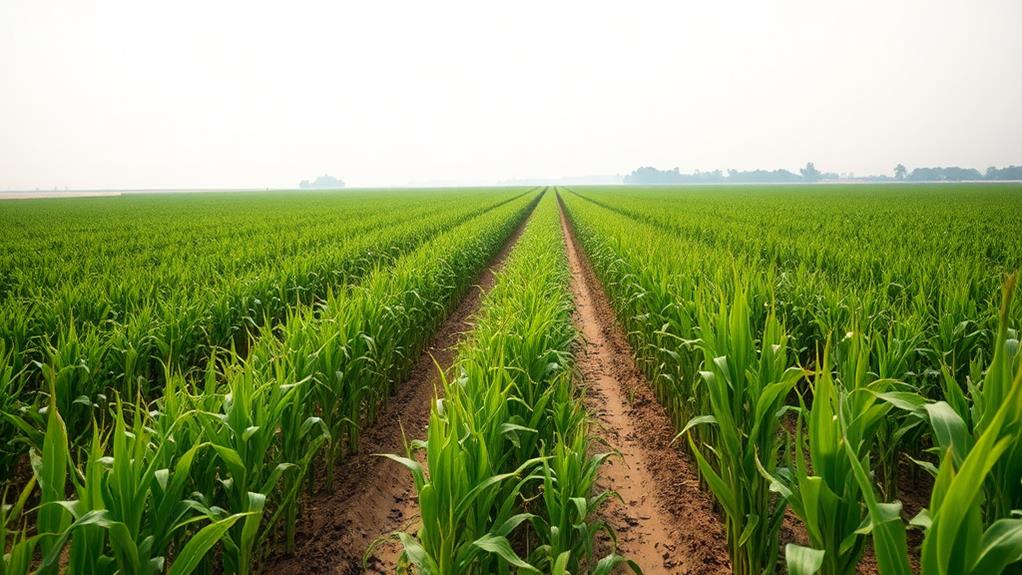
The environmental impact of corn production is a double-edged sword. On one hand, corn plays a significant role in mitigating climate change. You might be surprised to learn that a single acre of corn can remove about 8 tons of carbon dioxide from the atmosphere. This important carbon sequestration helps combat global warming.
However, corn farming also contributes to environmental degradation. It's a water-intensive crop, consuming a staggering 80% of agricultural water in the U.S. while occupying 25% of farmland. This puts immense pressure on water resources. Additionally, the use of glyphosate herbicides in corn production raises health concerns, with potential links to cancer.
Climate change poses a threat to corn cultivation itself. Projections indicate a 20% decrease in maize yields over the next decade, highlighting the urgent need for adaptive farming methods. To address these challenges, you can support sustainable practices like composting and crop rotation. These techniques help maintain soil health and reduce the negative environmental impacts of intensive corn production. By understanding these facts, you can make more informed choices about your food consumption and support environmentally responsible agricultural practices.
What Does Donatello Have in Common with the History of Corn?
The Renaissance sculptor Donatello and the history of corn both represent transformative eras in human culture. Donatello revolutionized art with his realistic sculptures, while corn became a staple that shaped civilizations. Unearthing interesting facts about donatello reveals how his creative influence paralleled the innovation of agriculture in ancient societies.
Cultural Significance Across Civilizations
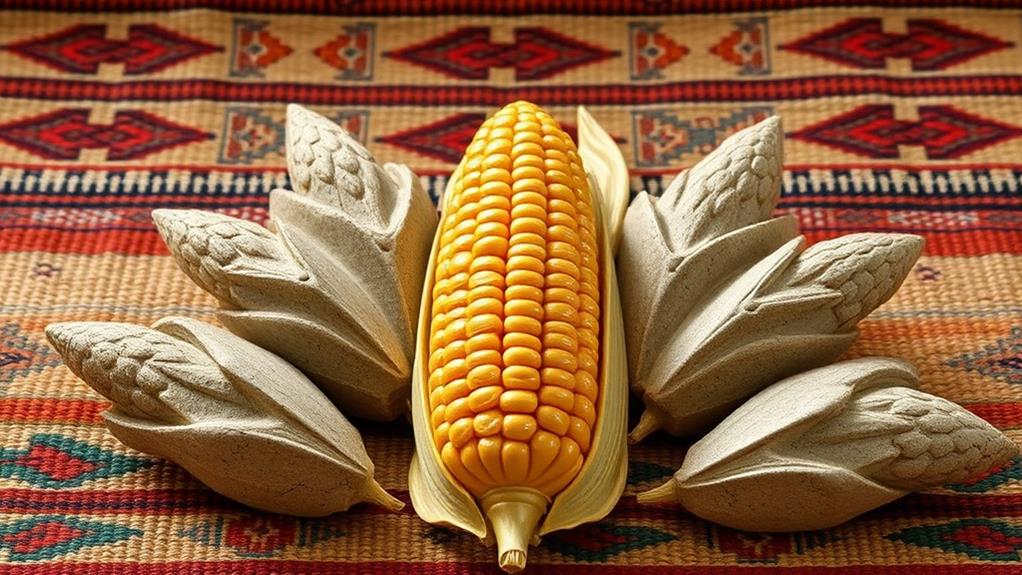
Throughout history, corn has played a pivotal role in shaping cultures and civilizations. Known as maize in many parts of the world, this versatile crop holds immense cultural significance, especially among indigenous communities in the Americas. You'll find corn deeply woven into the fabric of various societies, often appearing in creation myths and agricultural rituals.
Pre-Columbian civilizations, like the Aztecs and Mayans, revered corn as a sacred crop. It wasn't just a staple food; it was integral to their ceremonies and spiritual beliefs. The concept of the "Corn Mother" is a recurring figure in Native American folklore, symbolizing fertility and the nurturing aspects of agriculture.
Here's how corn's cultural importance manifests:
- Maize harvest celebrations and festivals
- Corn-based beverages like chicha used in social gatherings
- Corn imagery in art, pottery, and traditional clothing
You'll discover that corn's influence extends far beyond nutrition. It's a symbol of life, sustenance, and cultural identity. From ancient rituals to modern-day festivities, corn continues to play a vital role in maintaining social bonds and preserving traditions across various civilizations.
Frequently Asked Questions
What Are 5 Interesting Facts About Corn?
You might think corn is just a simple vegetable, but it's far more fascinating. Did you know that corn's been around for over 10,000 years? It's one of America's oldest crops. Every ear of corn has an even number of rows, typically 16, with about 800 kernels. The U.S. produces a third of the world's corn, and it has over 3,500 uses beyond food. Surprisingly, corn's also an environmental hero, with one acre removing 8 tons of CO2 from the atmosphere annually.
What Is the Unique Feature of Corn?
You'll find that corn's unique feature lies in its versatile classification. It's simultaneously a vegetable, grain, and fruit, depending on how it's used and its stage of ripeness. This multi-faceted nature sets corn apart from many other crops. You'll also notice that corn cobs always have an even number of rows, typically around 16, with about 800 kernels. Curiously, there's a one-to-one ratio between silk strands and kernels, showcasing corn's remarkable biological structure.
What Is the Uniqueness of Corn?
You'll find corn's uniqueness in its versatile classification. It's simultaneously a vegetable, grain, and fruit, depending on how it's used. You'll also notice its remarkable growth potential, with the tallest stalk reaching over 35 feet. You can use corn in over 3,000 ways, from food to biodegradable materials. When you examine an ear, you'll see about 800 kernels arranged in even-numbered rows, usually 16. Sweet corn's high sugar content makes it a time-sensitive treat.
Is There Anything Special About Corn?
You might think corn is just another crop, but there's more to it than meets the eye. Did you know corn kernels always come in even-numbered rows? It's true! Each kernel has its own silk strand, too. Corn's not just versatile in the kitchen; it's botanically unique, classified as a vegetable, grain, and fruit. It can grow incredibly tall, with the record-holder reaching over 35 feet. Plus, the U.S. produces a third of the world's corn supply, making it a global agricultural powerhouse.





